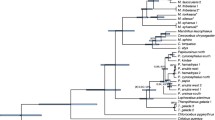Abstract
Platyrrhine primate taxonomy is a rapidly evolving area of research. The recent description of the Parecis titi monkey, Plecturocebus parecis, has raised substantial questions regarding the taxonomy, distribution, and evolutionary history of titi taxa from south-central Amazonia. There is only a single documented record of P. parecis, which is the type locality, with uncertainty regarding species monophyly. Moreover, there are questions surrounding the distribution and pelage patterns of the poorly studied P. cinerascens and P. parecis, which further highlight the uncertainty regarding the taxonomic validity of this new species. Here, we investigate the taxonomy, distribution, and evolutionary history of these lineages through new field work and assessment of pelage pigmentation patterns from 25 localities, as well as maximum likelihood and Bayesian phylogenetic reconstructions based on two mitochondrial and 11 nuclear loci for 19 and 10 specimens of Plecturocebus, respectively. Our mitochondrial results recover a paraphyletic arrangement for the four P. parecis type specimens that show three distinct haplotypes, with the holotype showing a close affinity to P. bernhardi. Our morphological analysis reveals a north–south clinal bleaching gradient through the Aripuanã-Sucundurí/Juruena interfluve from an all-grayish morphotype associated with P. cinerascens, through intermediary morphotypes with increasingly whitish hairs on the beard, hands, feet, and tail, to the most whitish morphotype described as P. parecis. Based on these findings, we present hypotheses to explain the taxonomy, distribution, and evolutionary history of P. cinerascens and P. parecis and discuss the significance of introgression among titi taxa from southern Amazonia given the lack of study systems for natural hybridization in platyrrhine primates.






Similar content being viewed by others
References
Boubli, J. P., Byrne, H., da Silva, M., Silva-Júnior, J., Costa Araújo, R., Bertuol, F., Gonçalves, J., de Melo, F. R., Rylands, A. B., Mittermeier, R. A., Silva, F. E., Nash, S. D., Canale, G., Alencar, R. M., Rossi, R. V., Carneiro, J., Sampaio, I., Farias, I. P., Schneider, H., & Hrbek, T. (2019). On a new species of titi monkey (Primates: Plecturocebus Byrne et al. 2016), from Alta Floresta, southern Amazon, Brazil. Molecular Phylogenetics and Evolution, 132, 117–137.
Byrne, H. (2017). Evolutionary history and taxonomy of the titi monkeys. PhD thesis, University of Salford, Manchester, UK.
Byrne, H., Rylands, A. B., Carneiro, J. C., Lynch Alfaro, J. W., Bertuol, F., da Silva, M. N. F., Messias, M., Groves, C. P., Mittermeier, R. A., Farias, I., Hrbek, T., Schneider, H., Sampaio, I., & Boubli, J. P. (2016). Phylogenetic relationships of the New World titi monkeys (Callicebus): First appraisal of taxonomy based on molecular evidence. Frontiers in Zoology, 13(10), 1–25.
Byrne, H., Lynch Alfaro, J. W., Sampaio, I., Farias, I., Schneider, H., Hrbek, T., & Boubli, J. P. (2018). Titi monkey biogeography: Parallel Pleistocene spread by Plecturocebus and Cheracebus into a post-Pebas Western Amazon. Zoologica Scripta, 47(5), 499–517.
Byrne, H., Rylands, A. B., Nash, S., & Boubli, J. P. (2020). On the taxonomic history and true identity of the collared titi, Cheracebus torquatus (Hoffmannsegg, 1807) (Platyrrhini, Callicebinae). Primate Conservation, 34, 13–52.
Carneiro, J. C., Silva Júnior, J. S., Sampaio, I., Pissinatti, A., Hrbek, T., Messias, M., Röhe, F., Farias, I., Boubli, J. P., & Schneider, H. (2016). Phylogeny of the titi monkeys of the Callicebus moloch group (Pitheciidae, Primates). American Journal of Primatology, 78(9), 904–913.
Cortés-Ortiz, L., Duda, T. F., Canales-Espinosa, D., García-Orduña, F., Rodríguez-Luna, E., & Bermingham, E. (2007). Hybridization in large-bodied New World primates. Genetics, 176(4), 2421–2425.
Costa-Araújo, R., Melo, F. R., Canale, G. R., Hernández-Rangel, S. M., Messias, M. R., Rossi, R. V., Silva, F. E., da Silva, M. N. F., Nash, S. D., Boubli, J. P., Farias, I. P., & Hrbek, T. (2019). The Munduruku marmoset: A new monkey species from southern Amazonia. PeerJ, 7, e7019.
Costa-Araújo, R., Silva-Jr., J. S., Boubli, J., Rossi, R. V., Canale, G. R., Melo, F. R., Bertuol, F., Silva, F. E., Silva, D. A., Nash, S. D., Sampaio, I., Farias, I. P., & Hrbek, T. (2021). An integrative analysis uncovers a new, pseudo-cryptic species of Amazonian marmoset (Primates: Callitrichidae: Mico) from the arc of deforestation. Scientific Reports. https://doi.org/10.1038/s41598-021-93943-w
Di Fiore, A., Chaves, P. B., Cornejo, F. M., Schmitt, C. A., Shanee, S., Cortés-Ortiz, L., Fagundes, V., Roos, C., & Pacheco, V. (2015). The rise and fall of a genus: Complete mtDNA genomes shed light on the phylogenetic position of yellow-tailed woolly monkeys, Lagothrix flavicauda, and on the evolutionary history of the family Atelidae (Primates: Platyrrhini). Molecular Phylogenetics and Evolution, 82B, 495–510.
Fernandes, A. M. (2013). Fine-scale endemism of Amazonian birds in a threatened landscape. Biodiversity and Conservation, 22, 2683–2694.
Ferrari, S. F., Iwanaga, S., Messias, M. R., Ramos, E. M., Ramos, P. C. S., da Cruz Neto, E. H., & Coutinho, P. E. G. (2000). Titi monkeys (Callicebus spp., Atelidae: Platyrrhini) in the Brazilian state of Rondônia. Primates, 41(2), 229–234.
Funk, D. J., & Omland, K. E. (2003). Species-level paraphyly and polyphyly: Frequency, causes, and consequences, with insights from animal mitochondrial DNA. Annual Review of Ecology, Evolution, and Systematics, 34(1), 397–423.
Gualda-Barros, J., Nascimento, F. O., & Amaral, M. K. (2012). A new species of Callicebus Thomas, 1903 (Primates, Pitheciidae) from the states of Mato Grosso and Pará, Brazil. Papéis Avulsos de Zoologia (São Paulo), 52(23), 261–279.
Gusmão, A. C., & da Costa, T. M. (2014). Registro de Callicebus cinerascens (Spix 1823) no Médio Vale Do Guaporé, Rondônia, Brasil. Neotropical Primates, 21(2), 210–211.
Gusmão, A. C., Messias, M. R., Carneiro, J. C., Schneider, H., de Alencar, T. B., Calouro, A. M., Dalponte, J. C., de Souza Mattos, F., Ferrari, S. F., Buss, G., & de Azevedo, R. B. (2019). A new species of titi monkey, Plecturocebus Byrne et al. 2016 (Primates, Pitheciidae), from southwestern Amazonia, Brazil. Primate Conservation, 33, 1–15.
Hershkovitz, P. (1988). Origin, speciation, and distribution of South American titi monkeys, genus Callicebus (Family Cebidae, Platyrrhini). Proceedings of the Academy of Natural Sciences of Philadelphia, 140(1), 240–272.
Hershkovitz, P. (1990). Titis, New World monkeys of the genus Callicebus (Cebidae, Platyrrhini): A preliminary taxonomic review. Fieldiana, Zoology New Series, 55, 1–109.
Latrubesse, E. M. (2002). Evidence of quaternary palaeohydrological changes in middle Amazonia: The Aripuanã-Roosevelt and Jiparaná fans. Zeitschrift für Geomorphologie, 129, 61–72.
Lovejoy, T. E., & Nobre, C. (2018). Amazon tipping point. Science Advances, 4(2), eaat2340.
Lynch Alfaro, J. W., Boubli, J. P., Paim, F. P., Ribas, C. C., da Silva, M. N. F., Messias, Röhe, F., Mercês, M. P., Silva Júnior, J. S., Silva, C. R., Pinho, G. M., Koshkarian, G., Nguyen, M. T. T., Harada, M. L., Rabelo, R. M., Queiroz, H. L., Alfaro, M. E., & Farias, I. P. (2015). Biogeography of squirrel monkeys (genus Saimiri): South-central Amazon origin and rapid pan-Amazonian diversification of a lowland primate. Molecular Phylogenetics and Evolution, 82B, 436–454.
Lynch-Alfaro, J. W., Silva Jr., J. S., & Rylands, A. B. (2012). How different are robust and gracile capuchin monkeys? An argument for the use of Sapajus and Cebus. American Journal of Primatology, 74, 273–286.
Maddison, W. P. (1997). Gene trees in species trees. Systematic Biology, 46(3), 523–536.
McKay, B. D., & Zink, R. M. (2010). The causes of mitochondrial DNA gene tree paraphyly in birds. Molecular Phylogenetics and Evolution, 54(2), 647–650.
Norconk, M. A. (2011). Sakis, uakaris, and titi monkeys. In C. J. Campbell, A. Fuentes, K. C. MacKinnon, S. K. Bearder, & R. M. Stumpf (Eds.), Primates in perspective (pp. 122–139). Oxford University Press.
Noronha, M. D. A., Spironello, W. R., & Ferreira, D. C. (2007). New occurrence records and eastern extension to the range of Callicebus cinerascens (Primates, Pitheciidae). Neotropical Primates, 14, 137–139.
Perelman, P., Johnson, W. E., Roos, C., Seuánez, H. N., Horvath, J. E., Moreira, M. A., Kessing, B., Pontius, J., Roelke, M., Rumpler, Y., Schneider, M. P. C., Silva, A., O'Brien, S. J., & Pecon-Slattery, J. (2011). A molecular phylogeny of living primates. PLoS Genetics, 7(3), e1001342.
Ronquist, F., Teslenko, M., van der Mark, P., Ayres, D. L., Darling, A., Höhna, S., Larget, B., Liu, L., Suchard, M. A., & Huelsenbeck, J. P. (2012). MrBayes 3.2: Efficient Bayesian phylogenetic inference and model choice across a large model space. Systematic Biology, 61(3), 539–542.
Sampaio, R., Dalponte, J. C., Rocha, E. C., Hack, R. O., Gusmão, A. C., Aguiar, K. M., Kuniy, A. A., de Sousa, J., & Silva-Júnior, J. (2012). Novos registros com uma extensão da distribuição geográfica de Callicebus cinerascens (Spix 1823). Mastozoología Neotropical, 19(1), 159–164.
Serrano-Villavicencio, J. E., Vendramel, R. L., & Garbino, G. S. T. (2017). Species, subspecies, or color morphs? Reconsidering the taxonomy of Callicebus Thomas, 1903 in the Purus–Madeira interfluvium. Primates, 58(1), 159–167.
Spix, J. B. (1823). Simiarum et vespertiliarum brasiliensis species novae. F. S. Hübschmann.
Stamatakis, A. (2014). RAxML version 8: A tool for phylogenetic analysis and post-analysis of large phylogenies. Bioinformatics, 30(9), 1312–1313.
Stamatakis, A., Hoover, P., & Rougemont, J. (2008). A rapid bootstrap algorithm for the RAxML Web servers. Systematic Biology, 57(5), 758–771.
Thom, G., & Aleixo, A. (2015). Cryptic speciation in the white- shouldered antshrike (Thamnophilus aethiops, Aves – Thamnophilidae): The tale of a transcontinental radiation across rivers in lowland Amazonia and the northeastern Atlantic Forest. Molecular Phylogenetics and Evolution, 82, 95–110.
Van Roosmalen, M. G. M., Van Roosmalen, T., & Mittermeier, R. A. (2002). A taxonomic review of the titi monkeys, genus Callicebus Thomas, 1903, with the description of two new species, Callicebus bernhardi and Callicebus stephennashi, from Brazilian Amazonia. Neotropical Primates, 10(Suppl), 1–52.
Vidal, M. D. (2012). Protocolo para coleta de dados sobre primatas em Unidades de Conservação da Amazônia. ICMBio.
Zinner, D., Arnold, M. L., & Roos, C. (2011). The strange blood: Natural hybridization in primates. Evolutionary Anthropology, 20(3), 96–103.
Acknowledgments
R Costa-Araújo was funded and supported by CNPq (140039/2018-1; 316321/2020-6), CAPES (001; 88881.189052/2018-01), Conservation Leadership Programme (F02304217), Global Wildlife Conservation’s Margot Marsh Primate Action Fund (6002856), CAPES/PRO-AMAZONIA/AUXPE (3261/2013), and Idea Wild, and is especially grateful for field support from the team of Secretaria Estadual de Meio Ambiente do Amazonas at Manaus and Apuí, the team of ONF Fazenda São Nicolau, José de Sousa e Silva Jr, Raimundo Rodrigues da Silva, Gustavo Canale, Fabiano R. de Melo, Catitu and Ivan Baptista da Silva. This study was financed, in part, by the Coordenação de Aperfeiçoamento de Pessoal de Nível Superior – Brasil (CAPES) – Finance Code 001. We thank Fabio Rohe for the use of his samples in the molecular analyses.
Author information
Authors and Affiliations
Contributions
HB and RCA originally conceived the ideas. HB performed the laboratory work and molecular analyses. RCA raised funds, carried out field expeditions, prepared specimens, and performed the morphological analysis. HB and RCA interpreted the molecular and morphological results. MM carried out field expeditions and contributed specimens for the molecular analyses. MNFS assisted in collecting field and morphological data. HB and RCA led the writing. TH, JPB, and IF raised funds and contributed to the design of the project and writing of the manuscript. All authors approved the final version of the article.
Corresponding author
Additional information
Handling Editor: Joanna M. Setchelll
Supplementary Information
ESM 1
(PDF 919 kb)
Rights and permissions
About this article
Cite this article
Byrne, H., Costa-Araújo, R., Farias, I.P. et al. Uncertainty Regarding Species Delimitation, Geographic Distribution, and the Evolutionary History of South-Central Amazonian Titi Monkey Species (Plecturocebus, Pitheciidae). Int J Primatol 45, 12–34 (2024). https://doi.org/10.1007/s10764-021-00249-9
Received:
Accepted:
Published:
Issue Date:
DOI: https://doi.org/10.1007/s10764-021-00249-9




